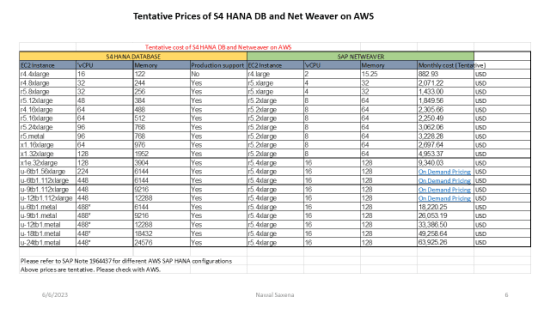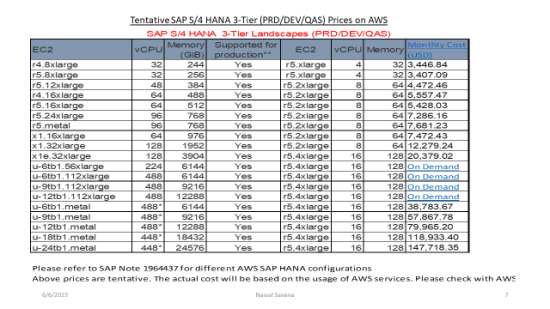What is our primary use case?
I have used SAP S4HANA on AWS. SAP S4HANA can be used on many hosting services, such as IBM RISE and Microsft Azure. When you're using someone else's hardware and being a tenant in it. Then those are some of the main players out there. You're going to become a business partner with who's hosting the software. You're a business partner with SAP, you've chosen to use SAP or whatever the ERP software is. Then it just comes down to, who you want to host your data on their servers.
How has it helped my organization?
When the PO is issued, the cost center budget is reduced immediately to highlight the fact that the PO has been issued and liability has been incurred. The vendor received a PO electronically to fill and the liability is set up in the vendor. Encumbrance in the cost center reduces the available budget for that cost center and GL account expense for the amount of the issued PO. All of this happens in real-time with ACDOCA universal table in S/4 Hana where all data is stored in real-time on Hana DB.
AWS if hosting, would be hosting and running the server but the functionality is in the way S/4 HANA stores data in columns, now using multicore processing. It uses the ACDOCA universal table. In the past, several tables had to be reconciled to get to actual GL balances and the data itself may have been updated in DB at various intervals, five minutes, ten minutes, one hour, or overnight, but with HANA it happens immediately in real-time.
With S/4 HANA you can see a PO and that the vendor has a PO. When the AP vendor shows liability in GL, the cost center is reflecting this liability and the profit is updated. Once the Goods Receipt and invoice are received, the PO is closed and line items are cleared. Now the cost center shows the actual expense in the cost center and GL along with Profit Center. The BS AP vendor shows zero balance, the liability credit has been reversed by cash payments during disbursements and cash in bank is reduced on the balance sheet.
The HANA DB product is running both OLTP and OLAP data in one single HANA database which in the past was in two separate databases, and actually a third report too. This speeds up the process, keeps data reporting more current and reduces the amount of server space for your data. This leads to lowering the IT cost of ownership, increasing the speed of data reporting, and reflection of transactions in GL and P&L. Data is reported in Fiori tiles or apps on your device.
You can see AP balances, open POs, cost center actual expenses versus budget versus committed expenses from outstanding POs, and the Profit Center versus budget. You can see up-to-date AP vendor balances and all of the data in real-time. No reconciliation is needed to get to true data with ACDOCA universal table. In the past, prior to S/4, the FAGAFLXA table had mostly GL data in it but reconciliation had to take place with Asset Accounting, Material Ledger and Profitability Accounting in order for Cost Centers, Profit Areas and GL to get to correct balances.
Now all balances can be found in a single source of truth, the ACDOCA table, with no need for reconciling. All transactions are real-time and are available instantly, with no batch running or delayed updates. Users and stakeholders can see real-time results of key indicators on their PC or devices via Fiori reporting apps.
What is most valuable?
SAP S4HANA on AWS has high performance. All the data is in one place and it's real-time. When you make an entry you don't have to wait a couple of minutes, hours, or overnight as something the batch process takes time. It is instantaneous and is available to everybody.
SAP S/4HANA is vastly superior because of its technology. You have a single database that normally you would have to have relational databases sharing data between each other. You had to duplicate data three times, whereas the technology from SAP S4HANA that they've come up with called HANA database is all of this is combined into one database. Therefore the memory is the performance speed, et cetera, of accessing the data is increased by a factor of 10.
Overall, how much memory you have to use is reduced substantially, because you don't need as much of this space because everything's combined into one place. It's a very interesting technology. Before it was this client-server database and moving around ECC R/3 was the first start of it. Now there's HANA on the back-end of the database and sitting in the front-end is Fiori which is this cloud-based application where you can have your iPhone, PC, iPad, thumb drive, or any kind of device, hooking up to the system and receive whatever data you want and it allows you to specify and modify the data.
If I'm a controller, I can look at want to know, such as how fast and what's going on with the accounts payable and which are outstanding. It can tell me about accounts receivable and what's the earnings per share. Whatever specific key data you want to see can be sent to you in some dashboards.
If you're in production you can see what's happening with production, what's going on with the supply chain, and it's all customizable and easily sent to you. It's all coming from the same exact single source of data, which is also new in the solution. It used to be in different countries, for example, if you have an entity in Germany, and they have to follow German law regulations about reporting, et cetera. You have one in France and have to follow their rules and another in the US and you have to follow the IOs and the SCC and the GAAP US accounting laws. Whereas the other ones follow their country's accounting laws and you're used to having these special ledgers, you'd have three different ledgers, for the different countries. All this is combined into one diverse ledger and accessed by everybody. All the data, there's only one set of data so there can't ever be some kind of a screw-up where somebody has different numbers than somebody else because the data has become out of sync. It's always in sync.
For how long have I used the solution?
I have used SAP S4HANA on AWS within the last 12 months.
Which solution did I use previously and why did I switch?
When comparing different hosting vendors it is hard to determine which one is the best.
When comparing SAP S4HANA to other ERPs it is different to tell which one is the best. However, a large percentage of businesses are using SAP versus other solutions, such as Oracle. This can indicate that they are doing very well and customers are satisfied. SAP spends more on R&D making their solution better than other solutions have in revenue.
How was the initial setup?
There are three different ways to implement SAP S4HANA. You can do an onsite deployment where you have your own servers and you purchase the software, license it, and control everything. You have the database, data, You've got the software. You've got the hardware. You've got to manage everything.
You can do a hybrid deployment where you have some of the hostings on AWS, Microsoft Azure, IBM, or other people who will host the server. They have the hardware and host the software for you and you can do a public version for sharing it with other people. Your database is secure. Nobody can see your data, but you're using a version of the software that everybody else is using because it has multi-customer capability.
The drawback of this tool versus an on-site tool is that you've got to upgrade the tool. The software is upgraded as it gets upgraded and you've got to be ready to change whatever processes and do whatever training you need to do.
You've got some control over if you want to have private data on a private server. You could have your data more private versus public but you're still running, a tenant on the same version of the software. Then there's a completely public version where it only serves as a software as a service where you are buying timed seats within an application. Everything is being run by a third party, the hardware, database, software, et cetera.
Having these three different ways to implement it, the fact that this has this database is a large benefit for users. If they're using an older version you will have to upgrade at some point. For example, it is similar to having an iPhone, where Apple sends an advisory out indicating they are no longer going to support the older versions. Microsoft does the same thing, if you are using Microsoft Windows version 10 eventually they will stop supporting it because Windows 11 is the most recent version available.
Right now that's starting to happen with the ECC, and SAP as a company wants you to be on the latest version. Since 2015, it's time for you to upgrade. We don't want to keep supporting this old version and this is what I know and understand about it.
Even with the economy slowing down and inflation going up and this is one reason why you want to invest in IT. You have to try to reduce costs somehow. People are upgrading and it is a larger install base, there's more activity going on in that space right now. SAP S4HANA is such a drastic change in technology. Many people have changed but a lot of the larger companies weren't making the change because it meant a very large change in the organization. Most people implemented SAP and what Germany did was different than what the US did, and what France did was different than what Japan did. When they do this, they have to align on how they will do things in general, such as the P2P procure-to-pay process. Their country-specific regulator would be put in there but if you are going to do the same thing. You're all running down the same system now.
I worked for a company, for example, that had 40 instances of SAP running, every one of them was different. That's hard to maintain. Imagine eliminating 40 different systems, and having one system. That system runs much better than the 40 in terms of speed, memory, and reporting capability.
What's my experience with pricing, setup cost, and licensing?
The vendors have different pricing, ways of serving, security, and providing the service. You go and compare the offerings. Some might be better with smaller companies. For example, Microsoft Azure can handle small and medium-sized companies best but still can cover some large companies. Whereas Amazon AWS and IBM are going to cover sized companies. There's no clear advantage. Probably Amazon AWS may have been the first to be certified by SAP as a cloud-hosting partner. Then Microsoft Azure and IBM were certified at the same time. You have to partner up and be certified by the software.
What other advice do I have?
When choosing a solution and you're completely new to ERPs and you're going out and doing analysis, what you're looking at is many factors, such as are you a Microsoft shop where you have Office365 with Outlook, Excel, and that's your standard company-wide solution. Then you're already really comfortable with Microsoft. You might go ahead and use Microsoft Azure for hosting and database management. You could be a shop that has always used IBM since mainframes and you just love IBM so you're going to stick with them. However, I have found Amazon AWS, they have a great reputation. This is very important to me.
Each one of the hosting vendors has its own way to provide the service and has its pros and cons. You have to know how many people are going to be using it, and what's the cost per seat. You have to do a cost analysis because they have different pricing based on what you want to do.
I rate SAP S4HANA on AWS a ten out of ten.
Disclosure: My company does not have a business relationship with this vendor other than being a customer.

















